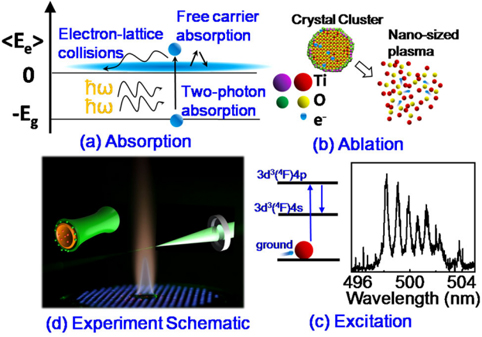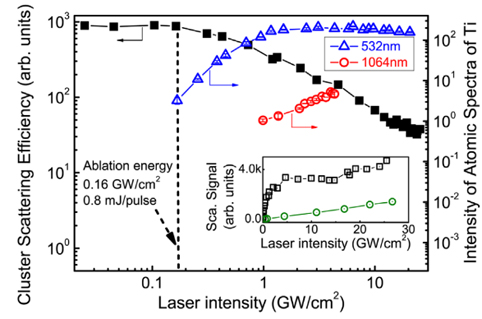Uncovering Absorption-Ablation-Excitation mechanism of PS-LIBS
—Breakthrough of a novel diagnostic method in high temperature nanoaerosol systems
Well-controlled flame and high temperature synthesis offers the possibility to produce active materials randomly mixed on the nano- and even atomic-scale with metastable phase in a single step with scalable production. In-situ laser diagnostics methods in such a multi-phase high-temperature environment are always desired for both studies in mechanisms of particle formation mechanism in laboratories and robust controlling of flame synthesis in industry.
In a series of papers since 2013, members of Prof. Shuiqing Li’s laboratory at Department of thermal engineering reported a novel laser diagnostic method called phase-selective laser-induced breakdown spectroscopy (PS-LIBS), which utilized in one-dimensional and two-dimensional diagnostic of gas-to-particle conversion process and doping mechanism in flame synthesis and coal combustion systems.

The absorption-ablation-excitation mechanisms of laser-nanoparticles interaction in flame field.
And now, in a paper appearing in Physical Review Letters jointly with collaborators from Rutgers and Yale, they successfully demonstrate that a novel absorption-ablation-excitation laser-matter interaction process does exist in PS-LIBS. Different from traditional laser induced breakdown spectroscopy (LIBS), PS-LIBS only breaks down particle phase but has little influence on gas phase. But this exciting phenomenon has ever confused the researchers for a long time.
“There must be a new physical picture when photons strike on nanoparticles”, said Ph. D student Yihua Ren, the first author of the paper. “It is almost impossible for the particles to directly absorb the laser energy in a thermal way at that visible wavelength. Transforming from crystalized particles into excited atom and even ions is not an easy job in energy.”
To characterize the change of particles in PS-LIBS, the authors designed an exquisite experiment to observe the absolute and time-resolved elastic scattering of clusters, which ensured the ablation process of particles and determined the ablation time of nanoparticles. Combining with the experiments of atomic emission under near-infrared laser environment, they further confirmed that absorption of laser light from nanoparticles was caused by conduction electrons by multi-photon ionization but not the traditional thermal effect.

The elastic scattering and PS-LIBS at different laser intensities.
The electron energy distribution is conducted by non-dimensionalizing the Fokker-Planck equation, during which Strouhal SlE, Peclet PeE, and Damk?hler DaE numbers are defined to characterize the laser-induced aerothermochemical environment. These numbers, analogous to traditional fluid, combustion and transport theory, successfully illustrate the electron transportation process in energy space under the studied weak laser environment. “This analogy from our daily teaching helps us simplify the complicate system into a clean and simple one and enable us to gain more insight into basic physics underlying of this novel phenomenon”, said Prof. Shuiqing Li, the corresponding author of the letter.
This work lays the theoretical foundation of further development and utilization of PS-LIBS, especially in systems like high-temperature material synthesis, astrophysical dust formation, atmospheric PM2.5 formation, etc. More importantly, the uncovered absorption-ablation-excitation laser-matter interaction mechanism supplies an omissive but important region in laser-matter interaction mechanisms.

